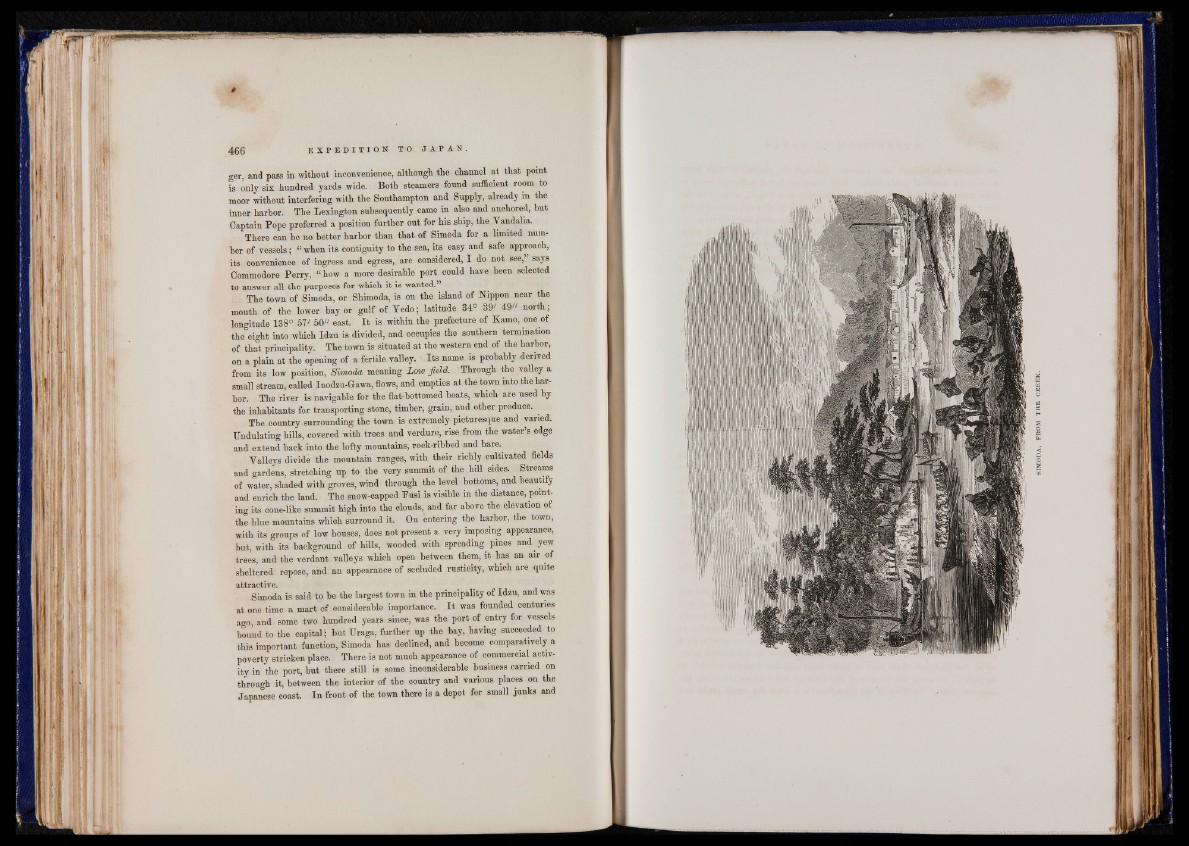
ger, and pass in without inconvenienoe, although the channel at that point
is only six hundred yards wide. Both steamers found sufficient room to
moor without interfering with the Southampton and Supply, already in the
inner harbor. The Lexington subsequently came in also and anchored, but
Captain Pope preferred a position further out for his ship, the Vandalia.
There can be no better harbor than that of Simoda for a limited number
of vessels; 1 when its contiguity to the sea, its easy and safe approach,
its convenience of ingress and egress, are considered, I do not see,” says
Commodore Perry, “ how a more desirable port could have been selected
to answer all the purposes for which it is wanted.”
The town of Simoda, or Shimoda, is on the island of Nippon near the
mouth of the lower bay or gulf of Yedo; latitude 34° 39' 49" north;
longitude 138° 57' 50" east. I t is within the prefecture of Kamo, one of
the eight into which Idzu is divided, and oocupies the southern termination
of that principality. The town is situated at the western end of the harbor,
on a plain at the opening of a fertile valley. ■ Its name is probably derived
from its low position, Simoda meaning Low field. Through the valley a
sama.ll stream, called Inodzu-Gawa, flows, and empties at the town into the harbor.
The river is navigable for the flat-bottomed boats, which are used by
the inhabitants for transporting stone, timber, grain, and otber produce, j
The country Burrounding the town is extremely picturesque and varied.
Undulating hills, covered with trees and verdure, rise from the water’s edge
and extend back into the lofty mountains, rock-ribbed and bare.
Valleys divide the mountain ranges, with their richly cultivated fields
and gardens, stretching up to the very summit of the hill sides. Streams
of water, shaded with groves, wind through the level bottoms, and beautify
and enrich the land. The snow-capped Fusi is visible in the distance, pointing
its cone-like summit high into the clouds, and far above the elevation of
the blue mountains which surround it. On entering the harbor, the town,
with its groups of low houses, does not present a very imposing appearance,
but, with its background of hills, wooded with spreading pines and yew
trees, and the verdant valleys which open between them, it has an air of
sheltered repose, and an appearance of secluded rusticity, which are quite
attractive.
Simoda is said to be the largest town in the principality of Idzu, and was
at one time a mart of considerable importance. I t was founded centuries
ago, and some two hundred years; since, was the port of entry for vessels
bound to the capital; but Uraga, further up the bay, having succeeded to
this important function, Simoda has declined, and become comparatively a
poverty stricken place. There is not much appearance of commercial activity
in the port, but there still is some inconsiderable business carried on
through it, between tbe interior of the country and various places on the
Japanese coast. In front of the town there is a depot for small junks and